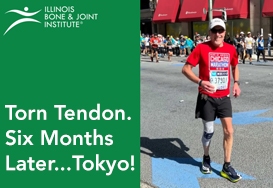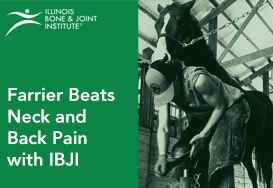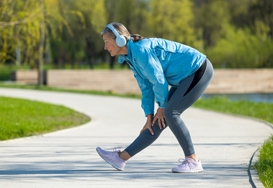This article is part of the Ultimate Guide to Knee Pain Relief.
The knee is a complex joint made up of various components and can be susceptible to a wide range of injuries. When you are experiencing knee pain it can be difficult to discern what the source of your pain might be and what can be done to fix it.
Read on to learn more about some of the most common knee injuries or conditions that IBJI treats, and the symptoms, causes, and typical treatments for each.
4 Common Knee Injuries or Condition
1. Arthritis
Typically, arthritis presents in middle-aged to older patients. Occasionally younger patients with a history of a significant prior injury could develop arthritis at a younger age, but generally, arthritis appears in patients over 40-50 years of age.
One of the more common symptoms that specialists look for with arthritis is pain at rest or at night. Other symptoms would be pain first thing in the morning or after sitting or being sedentary for a while, as the knee can get stiff and may feel better as the day goes on, however the pain can return with increased activity by the end of the day.
Treatments for arthritis vary based upon how long the patient has been experiencing pain, but in general if a patient has not yet tried any significant treatment prior to their first visit, typically a physician will start them on oral medications like Tylenol or NSAIDs, prescribe physical therapy which can be helpful, or try other options such as bracing the knee, or various topical medications to reduce pain in the knee. It may also help to modify daily activities to lessen the impact on the knee.
The next step after these less invasive options would be different types of injections. The most common being cortisone injections and viscosupplementation or gel injections.
Surgery is typically going to be the last resort when all other options fail to provide relief. From a surgical standpoint, arthritis does not respond well to knee arthroscopy. While there are some cases where the patient is experiencing a ‘locking’ or ‘catching’ in the knee it can be helpful, but in most cases, patients in severe pain will be candidates for a knee replacement.
2. Patellofemoral Pain
Patellofemoral pain is pain in the front of the knee. This is probably one of the most common conditions seen at IBJI. Sometimes the pain is related to an injury like a dislocated kneecap, or can be related to arthritis, but often times there is no specific injury. It can be caused by overuse, or increased activity without proper training or conditioning.
Sometimes this type of pain can be worse with prolonged sitting. Patients also tend to experience pain with stairs or motions like squatting. This condition is also referred to as ‘Runner’s Knee,’ so there is definitely some increased pain with increased running and activity.
Patients of all ages and backgrounds are susceptible to patellofemoral pain. While the pain is more likely to be tied to arthritis in older patients, in teens and younger adults it tends to be tied more to a specific injury or overuse.
Treatments for this kind of pain can be similar in nature to the initial treatments prescribed for arthritis like oral medications and bracing. Physical therapy can also be quite effective in helping with stretching and strengthening. Rarely is surgery needed for patients experiencing patellofemoral pain unless it is tied to a secondary issue like patellar instability, articular cartilage defects, or arthritis.
The recovery period for this type of pain varies from patient to patient. It can be a matter of a week or two, or several months. In most cases, especially in younger patients, symptoms will get better in 6-8 weeks. It depends how active they are and how dedicated they are to the treatments prescribed.
3. Meniscus Tears
The meniscus is the soft tissue or cartilage, which acts as a shock absorber for the knee. It helps take pressure off the articular cartilage, which is what wears down with arthritis, so the meniscus generally helps prevent the development of arthritis. While patients with a healthy meniscus can still develop arthritis, they are at higher risk of arthritis if the meniscus is damaged.
Meniscus tears can appear in patients from their mid-teens to much older. This injury can be associated with ACL tears, but isolated tears where no other ligaments are injured are possible. Oftentimes meniscus tears are caused by a traumatic injury, especially in younger, more active patients. It can be a fall or a direct blow to the knee, but more often tied to twisting and pivoting movements. Some patients do not remember a traumatic event at all, and it simply develops over time.
In most cases with meniscus tears, physicians are looking for pain associated with activity, rather than pain at rest. One the most common symptoms associated with meniscus tears is ‘joint line pain’ or pain on the inside (medial) or outside (lateral) part of the knee. Typically, with a meniscus tear the pain will be localized to one or both sides, depending on where the tear is. Oftentimes patients experience swelling, especially within a day or two after the injury. There are also mechanical symptoms like ‘locking’ or ‘catching’ where the meniscus can tear and prevent the knee from bending or straightening.
Treatments can vary based upon the age and activity level of the patient. Because meniscus tears typically do not heal on their own, surgery is usually a good option for young, healthy patients that want to get back to regular activity. If left untreated in a younger patient, the tear can get bigger, and over time, can contribute to the development of arthritis. In most cases with older patients, especially those with associated arthritis, physicians often begin with non-operative treatments like oral medications, physical therapy, and injections potentially before proceeding with surgery.
The recovery time for a meniscus tear depends on the specific procedure needed. For patients who undergo arthroscopy to clean out the tear (debridement) and a repair is not needed, recovery takes about 6-12 weeks to return to normal activity. For patients who need a repair of their meniscus, recovery can be a bit slower, lasting as long as 3-4 months or longer, depending on the patient.
4. Ligament Injuries
One of the most common ligament injuries that IBJI doctors see is an MCL (medial collateral ligament) injury. Typically, these injuries stem from a specific traumatic event, like a direct blow, fall, or a twisting injury. Similarly, ACL (anterior cruciate ligament) injuries are usually caused by a traumatic event, however, the majority of ACL injuries actually stem from non-contact events, like cutting, pivoting, or twisting. Some patients describe a ‘popping’ sound or feeling with an ACL tear.
For ACL injuries, typically patients will experience swelling very quickly within a day or so. In most cases patients with an MCL injury can do some weight-bearing, though they can benefit from a brace or immobilizer for some additional support. ACL injuries typically render patients unable to bear any weight at the time of the injury.
Most MCL injuries rarely require surgery, as they can heal on their own, however some severe cases do require surgery. A mild MCL sprain can heal within 2-3 weeks, whereas more severe injuries can take up to 6 weeks or longer to heal. In most cases, IBJI physicians like to start patients with MCL injuries on physical therapy right away to work on range of motion and strengthening. For ACL injuries, typically younger, more active patients are treated surgically in order to return to the same level of activity post-injury. Recovering from ACL surgery depends on the patient, but typically can be anywhere from 6 months to a year or more.
In patients who have a sedentary lifestyle or are not involved very active or involved in high cutting and pivoting activities like sports, ACL injuries can be treated non-operatively, if they are not experiencing any instability in the knee causing it to give out during normal daily activities. Physical therapy is the typical non-operative treatment for patients to regain range of motion and work on overall strengthening.
Get Relief from Your Knee Pain Today
Knee Care and Treatment at IBJI
Whether you’ve experienced an acute injury or are battling chronic knee pain, IBJI’s knee surgeons are here to help provide you with the necessary care for your ailment. Get the relief you are seeking with the help of IBJI.
Schedule online with an IBJI knee surgeon to discuss treatment options and create an individualized approach to your care.
Check out IBJI’s additional online resources for knee care to learn more about conditions and read patient testimonials.
Schedule online with a Knee Doctor →
*This content is for information only and is not intended to replace the diagnosis, treatment, or medical advice from your treating healthcare professionals. The content does not provide medical advice, does not constitute the practice of medicine or other healthcare professional services, and does not create a doctor-patient relationship. You should not rely on this information as a substitute, nor does it replace professional medical advice, diagnosis, or treatment. If you have concerns or questions, seek the advice of your healthcare professionals. If you think you may have a medical emergency, call your doctor or 911 immediately. Do not rely on electronic communications or communicate through this website for immediate, urgent medical needs. This website is not designed to facilitate medical emergencies. The use of the information is at the reader’s own risk. The links are provided for information and convenience only. We cannot accept responsibility for the sites linked or the information found here. A link does not imply an endorsement of a site.





